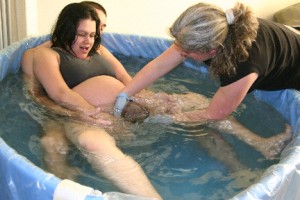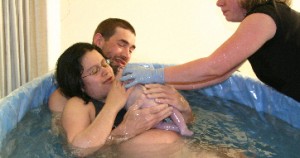Water birth is an option
 Water has long been used by women to ease the discomforts of labor. Whether standing in a shower, sitting in your own bathtub at home, or fully reclining in an large tub built just for laboring, most women find instant relief of their labor discomfort from the use of water. Their relaxed bodies release fewer stress hormones and their labors proceed more quickly and easily, with less discomfort. No wonder that the idea of water immersion is so appealing to most women.
Water has long been used by women to ease the discomforts of labor. Whether standing in a shower, sitting in your own bathtub at home, or fully reclining in an large tub built just for laboring, most women find instant relief of their labor discomfort from the use of water. Their relaxed bodies release fewer stress hormones and their labors proceed more quickly and easily, with less discomfort. No wonder that the idea of water immersion is so appealing to most women.
To clients who wish to take advantage of this option for their birth, the one obvious need is the tub. If the client has a deep tub, such as a Jacuzzi, in her home, this is an ideal option for her. Use of a standard bathtub or shower may be sufficient, but most women find that the greatest degree of relaxation is achieved if the belly can be submerged as fully as possible. For our clients who want to have the deeper water available but do not have a built-in Jacuzzi-type tub, we offer the use of our portable birthing tub. It is about 5 feet in diameter and about 3 feet deep, holding about120 gallons of water when filled. Women may enter the tub at any time during active labor, although waiting until she has dilated to at least 5 cms is recommended. Often, the relaxation afforded by the warm water will allow you to dilate more quickly and easily, resulting in a shorter, more comfortable labor.
Besides the tub itself, we also provide:

- A disposable plastic liner
- A foam pad upon which to set up the tub
- A submersible pump, to drain the water easily
- A few faucet adapters, to connect the hose to your sink
- A floating thermometer
- A heating element that keeps the water warm once it has reached a certain depth.
- A foam lid, to keep the water warm and clean when you’re out of the tub
- Complete directions and recommendations on tub use and cleaning
Clients are expected to provide:
- a new, never-used garden hose for filling and draining the tub
- Lots of extra towels
Considerations for tub use and placement

- Location of electrical outlets
- Size and temperature-setting of hot water heater
- Sturdiness of flooring where tub will be placed
- Availability of ample bath towels
- Ability to protect flooring under tub
- Easy access to out-of-tub birthing/recovery area (bed, couch, mattress on floor, etc)
- Proximity to bathroom (true for all births!)

Laboring in the water is almost always possible and usually very helpful. If it is also your intention to give birth in the water, we are comfortable with this as a goal and willing to do our best to help you achieve it. However, like anything else in a birth plan, this needs to be flexible; if events occur during your labor that contraindicate water birthing, you must be willing to follow the course of action that is best for you and your baby, even if this means birthing outside the tub.
Waterbirth: A Gentle Beginning for a New Life
Article from the Waterbirth International WebSite
 Most people find great comfort and repose with water. Perhaps because we begin our lives surrounded in liquid in the womb, this basic familiarity stays with us throughout our lives. Human beings are comprised primarily of water, and many special characteristics we have link us to aquatic mammals, perhaps carrying the memory of a time when the human species had an “aquatic interlude.”
Most people find great comfort and repose with water. Perhaps because we begin our lives surrounded in liquid in the womb, this basic familiarity stays with us throughout our lives. Human beings are comprised primarily of water, and many special characteristics we have link us to aquatic mammals, perhaps carrying the memory of a time when the human species had an “aquatic interlude.”
Human beings’ natural alliance with water is best witnessed in human babies who can swim naturally and easily long before they learn to sit up or crawl. During their first year of life, babies will calmly and happily paddle underwater, gazing around with eyes wide open. When they need to breathe, they naturally paddle toward the surface of the water before taking a breath. Babies instinctively know not to breathe while their heads are still submerged underwater. They wait until they reach the surface of the water before breathing. It seems to be only later that humans lose these instincts and become more prone to drowning.
Soaking in a tub of water to ease labor sounds inviting to most women. However, laboring in water does more than merely relax and comfort the woman. Resting in a warm tub of water actually facilitates the progression of the latter stages of labor. Many women report a sensation like an “energy surge” that moves through them as soon as they step into the water. While a woman in labor relaxes in a warm pool, free from gravity’s pull on her body, and with sensory stimulation reduced, her body is less likely to secrete stress-related hormones that can slow or complicate labor. This allows her body to produce the pain-inhibitors, endorphins, that ease her discomfort and facilitate labor’s progress.
The hormones that are released during stress, noradrenaline and catecholamines, actually raise the blood pressure and can inhibit or slow labor. Dr. Serge Weisel presented his findings from a study of women laboring in warm water in Belgium at the 1987 Pre & Perinatal Psychology Association of North America conference. Weisel stated that women with hypertension (high blood pressure) experienced a drop in blood pressure between 10 to 15 minutes after entering a warm bath.
Being more relaxed physically, a laboring woman is able to relax mentally. Many women, midwives and doctors acknowledge the analgesic effect of water. One obstetrical nurse who had a waterbirth described sitting in a tub of warm water during labor as similar to “getting a shot of demerol, but without the side effects.” Others have referred to the pool labor as “a wet epidural.” Women achieve a level of comfort in the water that in turn reduces their levels of fear and stress. Women’s perception of pain is greatly influenced by their levels of anxiety. When labor becomes physically easier, a woman’s ability to calmly concentrate is improved, and she is able to focus inward on the birth processes.
Many women report being better able to concentrate once they get into the water. Doctors and midwives who attend waterbirths find that the mere sight and sound of water pouring into the tub helps some women release whatever inhibitions were slowing the birth, at times so quickly that the birth occurs even before the pool is filled. Oftentimes women get in the pool to labor and the birth happens before they can get out of the pool.
Water helps some women reach a state of consciousness in which their fear and resistance are diminished or removed completely; then their bodies relax, and their babies are born in the easiest way possible. Mothers whose babies are born naturally in this way feel not only relief at the end of their labor; even if exhausted, they often feel exhilarated, ecstatic and euphoric from having experienced their birth fully and in such a wonderful way, and knowing the baby also has experienced little or no trauma! This is a positive result unknown in hospitals not equipped for water birthing.
Another benefit of waterbirth is the elasticity that water imparts to the tissues of the perineum, reducing the incidence and severity of tearing and the need for painful stitches or episiotomies. On the occasion of his 100th water delivery, Michel Odent reported that in the 100 waterbirths he had attended, there were no episiotomies performed and only 29 cases of tearing, all of which were minor surface tears. A 1989 nationwide survey published in The Journal of Nurse Midwifery on the use of water for labor and birth reported less incidents of perineal tearing with less severity.
The ease of the mother who labors and gives birth in water becomes the ease of the child who is born in the water, as well. Gentle alternatives that make birth easier for the mother most likely will make birth easier for the child. Their body responses are intricately linked. While the child is in the womb and when he is passing through the birth canal, the mother’s experience influences the child’s experience. The emotions the mother feels can also be felt by the child because the hormones her body secretes in response to her emotions are absorbed by the child.
In a medically controlled birth, any drugs or synthetic hormones that the mother receives are also be received by the child. If the mother’s delivery is easy and smooth, so too is the child’s birth. He spends less time in the cramped birth canal and is free from the fear, frustration or other painful emotions that a long and difficult labor might arouse in the mother.
The baby emerges into the water and is “caught” either by the mother herself or the birth attendant. In the water, the child has freedom of movement within familiar fluid surroundings. A baby’s limbs can also unfold with greater ease during those first moments when he leaves his mother’s body and enters the water. The water offers a familiar comfort after the stress of the birth, reassuring the child and allowing his bodily systems time to organize.
During the birth babies often open their eyes, move in all directions and use their limbs. The shock and sensory overload that are so often a part of conventional birth are diminished. Lights and sounds are softer when perceived from under the water, and even the touch of his mother’s skin to his own tender skin is softened by the presence of a familiar element: water.
Also, in some cases, the mother may wish the entire family to be with her during this very special time for everyone. This element of water, familiar and secure for the baby, becomes comforting and relaxing for the mother. The mother and baby together are profoundly affected by this gentlest of gentle births.
